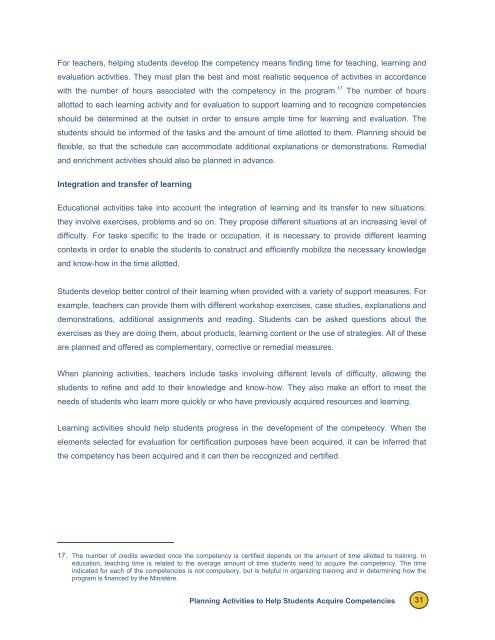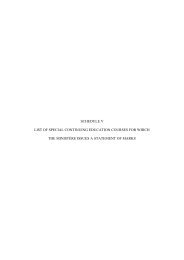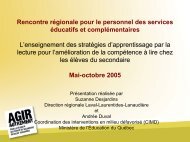Reference Framework for Planning Learning and Evaluation Activities
Reference Framework for Planning Learning and Evaluation Activities
Reference Framework for Planning Learning and Evaluation Activities
You also want an ePaper? Increase the reach of your titles
YUMPU automatically turns print PDFs into web optimized ePapers that Google loves.
For teachers, helping students develop the competency means finding time <strong>for</strong> teaching, learning <strong>and</strong><br />
evaluation activities. They must plan the best <strong>and</strong> most realistic sequence of activities in accordance<br />
with the number of hours associated with the competency in the program. 17 The number of hours<br />
allotted to each learning activity <strong>and</strong> <strong>for</strong> evaluation to support learning <strong>and</strong> to recognize competencies<br />
should be determined at the outset in order to ensure ample time <strong>for</strong> learning <strong>and</strong> evaluation. The<br />
students should be in<strong>for</strong>med of the tasks <strong>and</strong> the amount of time allotted to them. <strong>Planning</strong> should be<br />
flexible, so that the schedule can accommodate additional explanations or demonstrations. Remedial<br />
<strong>and</strong> enrichment activities should also be planned in advance.<br />
Integration <strong>and</strong> transfer of learning<br />
Educational activities take into account the integration of learning <strong>and</strong> its transfer to new situations:<br />
they involve exercises, problems <strong>and</strong> so on. They propose different situations at an increasing level of<br />
difficulty. For tasks specific to the trade or occupation, it is necessary to provide different learning<br />
contexts in order to enable the students to construct <strong>and</strong> efficiently mobilize the necessary knowledge<br />
<strong>and</strong> know-how in the time allotted.<br />
Students develop better control of their learning when provided with a variety of support measures. For<br />
example, teachers can provide them with different workshop exercises, case studies, explanations <strong>and</strong><br />
demonstrations, additional assignments <strong>and</strong> reading. Students can be asked questions about the<br />
exercises as they are doing them, about products, learning content or the use of strategies. All of these<br />
are planned <strong>and</strong> offered as complementary, corrective or remedial measures.<br />
When planning activities, teachers include tasks involving different levels of difficulty, allowing the<br />
students to refine <strong>and</strong> add to their knowledge <strong>and</strong> know-how. They also make an ef<strong>for</strong>t to meet the<br />
needs of students who learn more quickly or who have previously acquired resources <strong>and</strong> learning.<br />
<strong>Learning</strong> activities should help students progress in the development of the competency. When the<br />
elements selected <strong>for</strong> evaluation <strong>for</strong> certification purposes have been acquired, it can be inferred that<br />
the competency has been acquired <strong>and</strong> it can then be recognized <strong>and</strong> certified.<br />
17. The number of credits awarded once the competency is certified depends on the amount of time allotted to training. In<br />
education, teaching time is related to the average amount of time students need to acquire the competency. The time<br />
indicated <strong>for</strong> each of the competencies is not compulsory, but is helpful in organizing training <strong>and</strong> in determining how the<br />
program is financed by the Ministère.<br />
<strong>Planning</strong> <strong>Activities</strong> to Help Students Acquire Competencies 31




